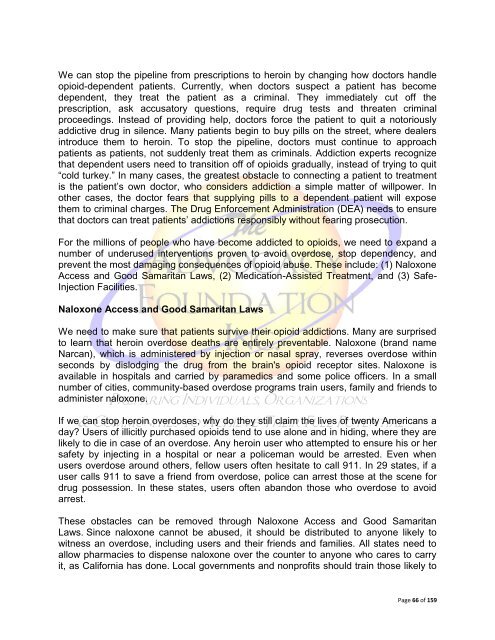The Economic Consequences of Opioid Addiction in America
The Economic Consequences of Opioid Addiction in America
The Economic Consequences of Opioid Addiction in America
Create successful ePaper yourself
Turn your PDF publications into a flip-book with our unique Google optimized e-Paper software.
We can stop the pipel<strong>in</strong>e from prescriptions to hero<strong>in</strong> by chang<strong>in</strong>g how doctors handle<br />
opioid-dependent patients. Currently, when doctors suspect a patient has become<br />
dependent, they treat the patient as a crim<strong>in</strong>al. <strong>The</strong>y immediately cut <strong>of</strong>f the<br />
prescription, ask accusatory questions, require drug tests and threaten crim<strong>in</strong>al<br />
proceed<strong>in</strong>gs. Instead <strong>of</strong> provid<strong>in</strong>g help, doctors force the patient to quit a notoriously<br />
addictive drug <strong>in</strong> silence. Many patients beg<strong>in</strong> to buy pills on the street, where dealers<br />
<strong>in</strong>troduce them to hero<strong>in</strong>. To stop the pipel<strong>in</strong>e, doctors must cont<strong>in</strong>ue to approach<br />
patients as patients, not suddenly treat them as crim<strong>in</strong>als. <strong>Addiction</strong> experts recognize<br />
that dependent users need to transition <strong>of</strong>f <strong>of</strong> opioids gradually, <strong>in</strong>stead <strong>of</strong> try<strong>in</strong>g to quit<br />
“cold turkey.” In many cases, the greatest obstacle to connect<strong>in</strong>g a patient to treatment<br />
is the patient’s own doctor, who considers addiction a simple matter <strong>of</strong> willpower. In<br />
other cases, the doctor fears that supply<strong>in</strong>g pills to a dependent patient will expose<br />
them to crim<strong>in</strong>al charges. <strong>The</strong> Drug Enforcement Adm<strong>in</strong>istration (DEA) needs to ensure<br />
that doctors can treat patients’ addictions responsibly without fear<strong>in</strong>g prosecution.<br />
For the millions <strong>of</strong> people who have become addicted to opioids, we need to expand a<br />
number <strong>of</strong> underused <strong>in</strong>terventions proven to avoid overdose, stop dependency, and<br />
prevent the most damag<strong>in</strong>g consequences <strong>of</strong> opioid abuse. <strong>The</strong>se <strong>in</strong>clude: (1) Naloxone<br />
Access and Good Samaritan Laws, (2) Medication-Assisted Treatment, and (3) Safe-<br />
Injection Facilities.<br />
Naloxone Access and Good Samaritan Laws<br />
We need to make sure that patients survive their opioid addictions. Many are surprised<br />
to learn that hero<strong>in</strong> overdose deaths are entirely preventable. Naloxone (brand name<br />
Narcan), which is adm<strong>in</strong>istered by <strong>in</strong>jection or nasal spray, reverses overdose with<strong>in</strong><br />
seconds by dislodg<strong>in</strong>g the drug from the bra<strong>in</strong>'s opioid receptor sites. Naloxone is<br />
available <strong>in</strong> hospitals and carried by paramedics and some police <strong>of</strong>ficers. In a small<br />
number <strong>of</strong> cities, community-based overdose programs tra<strong>in</strong> users, family and friends to<br />
adm<strong>in</strong>ister naloxone.<br />
If we can stop hero<strong>in</strong> overdoses, why do they still claim the lives <strong>of</strong> twenty <strong>America</strong>ns a<br />
day? Users <strong>of</strong> illicitly purchased opioids tend to use alone and <strong>in</strong> hid<strong>in</strong>g, where they are<br />
likely to die <strong>in</strong> case <strong>of</strong> an overdose. Any hero<strong>in</strong> user who attempted to ensure his or her<br />
safety by <strong>in</strong>ject<strong>in</strong>g <strong>in</strong> a hospital or near a policeman would be arrested. Even when<br />
users overdose around others, fellow users <strong>of</strong>ten hesitate to call 911. In 29 states, if a<br />
user calls 911 to save a friend from overdose, police can arrest those at the scene for<br />
drug possession. In these states, users <strong>of</strong>ten abandon those who overdose to avoid<br />
arrest.<br />
<strong>The</strong>se obstacles can be removed through Naloxone Access and Good Samaritan<br />
Laws. S<strong>in</strong>ce naloxone cannot be abused, it should be distributed to anyone likely to<br />
witness an overdose, <strong>in</strong>clud<strong>in</strong>g users and their friends and families. All states need to<br />
allow pharmacies to dispense naloxone over the counter to anyone who cares to carry<br />
it, as California has done. Local governments and nonpr<strong>of</strong>its should tra<strong>in</strong> those likely to<br />
Page 66 <strong>of</strong> 159

















